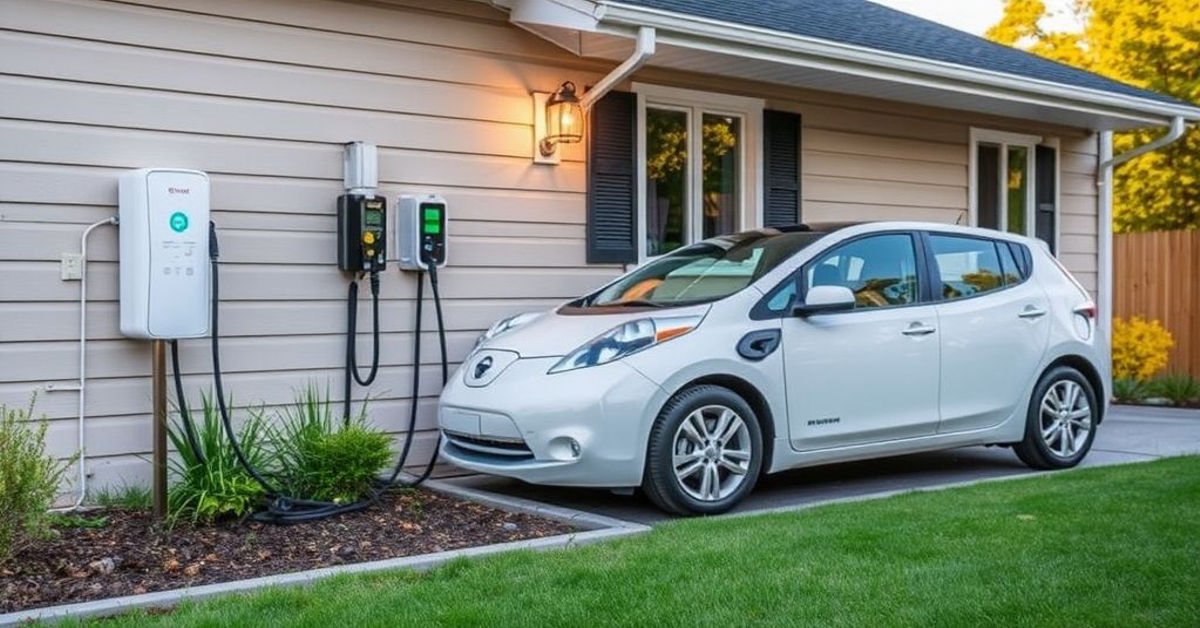Home EV Charging Station Installation USA continue to gain popularity across the United States, the demand for home EV charging stations has surged. Installing a home charging station offers unparalleled convenience, cost savings, and contributes to a greener environment. This comprehensive guide provides an in-depth look at the installation process, costs, benefits, and available incentives for homeowners considering an EV charging station.
Understanding EV Charging Levels
Before embarking on the installation journey, it’s essential to understand the different types of EV chargers available:
Level 1 Chargers
-
Power Source: Standard 120-volt household outlet.
-
Charging Time: Approximately 20–24 hours for a full charge.
-
Ideal For: Plug-in hybrid electric vehicles (PHEVs) or those with minimal daily driving needs.
Level 2 Chargers
-
Power Source: 240-volt outlet, similar to those used for large appliances.
-
Charging Time: Approximately 4–8 hours for a full charge.
-
Ideal For: Fully electric vehicles (EVs) and households with higher daily driving distances.
DC Fast Chargers (Level 3)
-
Power Source: Direct current (DC) at high voltage.
-
Charging Time: Approximately 30 minutes for an 80% charge.
-
Ideal For: Commercial locations or public charging stations; not typically used in residential settings due to high installation costs.
Steps to Install a Home EV Charging Station
1. Assess Your Home’s Electrical Capacity
Before selecting a charger, ensure your home’s electrical system can handle the additional load. A licensed electrician can evaluate your panel’s capacity and determine if an upgrade is necessary.
2. Choose the Right Charger
Select a Level 2 charger compatible with your EV model. Popular options include:
-
ChargePoint Home Flex: Offers adjustable amperage and Wi-Fi connectivity.
-
Tesla Wall Connector: Designed specifically for Tesla vehicles but compatible with others using an adapter.
3. Obtain Necessary Permits
Check with local authorities to determine if permits are required for installation. Most municipalities require permits to ensure safety and code compliance.
4. Hire a Licensed Electrician
Engage a certified electrician experienced in EV charger installations. They will handle the electrical work, secure permits, and ensure the installation meets local codes.
5. Install the Charger
The electrician will install the charger, which includes mounting the unit, connecting it to the electrical panel, and testing the system to ensure proper functionality.
6. Register the Charger
Some manufacturers require registration for warranty purposes and to receive software updates. Follow the manufacturer’s instructions for registration.
Costs Associated with Installation
The cost of installing a home EV charging station can vary based on several factors:
-
Charger Unit: $500–$700 for a Level 2 charger.
-
Electrical Panel Upgrade: $500–$2,000, if necessary.
-
Installation Labor: $300–$1,000, depending on complexity.
-
Permits: $50–$500, varying by location.
On average, homeowners can expect to pay between $1,000 and $3,000 for a complete installation.
Benefits of Home EV Charging Stations
Convenience
Charge your EV overnight, ensuring it’s ready each morning without the need to visit public charging stations.
Cost Savings
Charging at home is generally less expensive than using public chargers, especially with time-of-use electricity rates.
Increased Property Value
Homes equipped with EV charging stations may see an increase in property value, appealing to potential buyers interested in sustainable living.
Environmental Impact
By charging with renewable energy sources, homeowners can significantly reduce their carbon footprint.
Available Incentives and Rebates
Several federal, state, and local programs offer financial incentives for installing home EV charging stations:
Federal Tax Credit
Under the Inflation Reduction Act, homeowners can claim a tax credit of 30% of the installation cost, up to $1,000. This credit applies to both the charger and installation expenses Kiplinger.
State and Local Incentives
Many states and local utilities offer additional rebates and incentives. For instance:
-
California: Offers rebates up to $1,000 for eligible residents.
-
New York: Provides incentives through the Charge Ready NY program NYSERDA.
Check with your local utility provider and state energy office for available programs.
Choosing a Professional Installer
Selecting a qualified installer is crucial for ensuring a safe and efficient installation. Consider the following when choosing an installer:
-
Certifications: Ensure the electrician is licensed and certified to perform EV charger installations.
-
Experience: Look for professionals with experience in residential EV charger installations.
-
References: Ask for and check references or reviews from previous clients.
-
Warranty: Confirm that the installer offers a warranty on their work.
Maintenance and Troubleshooting
Regular maintenance ensures the longevity and efficiency of your EV charging station:
-
Regular Inspections: Have the system inspected annually by a licensed electrician.
-
Keep Clean: Ensure the charging unit and cables are free from debris and damage.
-
Software Updates: Periodically check for and install any software updates provided by the manufacturer.
If issues arise, consult the manufacturer’s troubleshooting guide or contact customer support for assistance.
Future Trends in Home EV Charging
The EV industry is rapidly evolving, and several trends are shaping the future of home charging:
-
Smart Charging: Integration with home energy management systems allows for optimized charging schedules and energy usage.
-
Vehicle-to-Grid (V2G) Technology: Enables EVs to supply power back to the grid, supporting energy resilience.
-
Wireless Charging: Research is underway to develop wireless charging solutions, eliminating the need for physical connectors.
Conclusion
Installing a home EV charging station is a forward-thinking investment that offers convenience, cost savings, and environmental benefits. By understanding the installation process, associated costs, available incentives, and future trends, homeowners can make informed decisions that align with their sustainable living goals. Always consult with certified professionals and take advantage of available incentives to maximize the benefits of your home EV charging station.

2 thoughts on “Comprehensive Guide to Home EV Charging Station Installation in the USA”